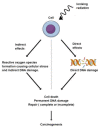Cancer Studies under Space Conditions: Finding Answers Abroad
- PMID: 35052703
- PMCID: PMC8773191
- DOI: 10.3390/biomedicines10010025
Cancer Studies under Space Conditions: Finding Answers Abroad
Abstract
In this review article, we discuss the current state of knowledge in cancer research under real and simulated microgravity conditions and point out further research directions in this field. Outer space is an extremely hostile environment for human life, with radiation, microgravity, and vacuum posing significant hazards. Although the risk for cancer in astronauts is not clear, microgravity plays a thought-provoking role in the carcinogenesis of normal and cancer cells, causing such effects as multicellular spheroid formation, cytoskeleton rearrangement, alteration of gene expression and protein synthesis, and apoptosis. Furthermore, deleterious effects of radiation on cells seem to be accentuated under microgravity. Ground-based facilities have been used to study microgravity effects in addition to laborious experiments during parabolic flights or on space stations. Some potential 'gravisensors' have already been detected, and further identification of these mechanisms of mechanosensitivity could open up ways for therapeutic influence on cancer growth and apoptosis. These novel findings may help to find new effective cancer treatments and to provide health protection for humans on future long-term spaceflights and exploration of outer space.
Keywords: gene expression; gravisensors; gravitation; mechanobiology; neoplasms; radiation; review; weightlessness.
Conflict of interest statement
The authors declare no conflict of interest. The funders had no role in the design of the study; in the collection, analyses, or interpretation of data; in the writing of the manuscript; or in the decision to publish the results.
Figures





References
-
- Hassanpour S.H., Dehghani M. Review of cancer from perspective of molecular. J. Cancer Res. Pract. 2017;4:127–129. doi: 10.1016/j.jcrpr.2017.07.001. - DOI
Publication types
Grants and funding
LinkOut - more resources
Full Text Sources

